
Virunga National Park is a national park in the Albertine Rift Valley in the eastern part of the Democratic Republic of the Congo. It was created in 1925. In elevation, it ranges from 680 m (2,230 ft) in the Semliki River valley to 5,109 m (16,762 ft) in the Rwenzori Mountains. From north to south it extends approximately 300 km (190 mi), largely along the international borders with Uganda and Rwanda in the east. It covers an area of 8,090 km2 (3,120 sq mi).
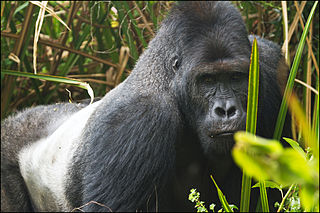
The eastern lowland gorilla or Grauer's gorilla is a Critically Endangered subspecies of eastern gorilla endemic to the mountainous forests of eastern Democratic Republic of the Congo. Important populations of this gorilla live in the Kahuzi-Biega and Maiko National Parks and their adjacent forests, the Tayna Gorilla Reserve, the Usala forest and on the Itombwe Massif.
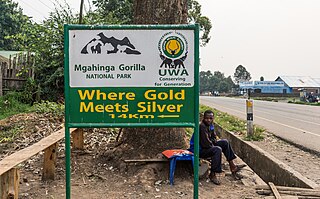
Mgahinga Gorilla National Park is a national park in southwestern Uganda. It was created in 1991 and covers an area of 33.9 km2 (13.1 sq mi).

The Albertine Rift is the western branch of the East African Rift, covering parts of Uganda, the Democratic Republic of the Congo (DRC), Rwanda, Burundi and Tanzania. It extends from the northern end of Lake Albert to the southern end of Lake Tanganyika. The geographical term includes the valley and the surrounding mountains.

The eastern gorilla is a critically endangered species of the genus Gorilla and the largest living primate. At present, the species is subdivided into two subspecies. There are 6,800 eastern lowland gorillas or Grauer’s gorillas and 1,000 mountain gorillas. Illegal hunting threatens the species.
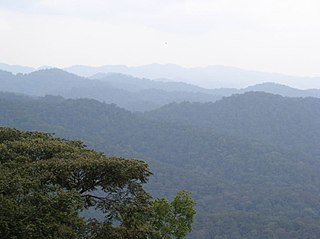
The Albertine Rift montane forests is a tropical moist broadleaf forest ecoregion in east-central Africa. The ecoregion covers the mountains of the northern Albertine Rift, and is home to distinct Afromontane forests with high biodiversity.
Grauer's swamp warbler is a species of Old World warbler in the family Locustellidae. It is found in Burundi, Democratic Republic of the Congo, Rwanda, and Uganda. Its natural habitats are freshwater lakes and freshwater marshes. It is threatened by habitat loss.
Cardioglossa cyaneospila is a species of frog in the family Arthroleptidae. It is endemic to the Albertine Rift area in eastern Democratic Republic of the Congo, southwestern Uganda, Rwanda, and southwestern Burundi. It was described in 1950 by Raymond Laurent based on specimens collected in 1949. No new records were published until 2011. Recent research has uncovered both old unpublished records and several new records, and the conservation status was changed from "data deficient" to "near threatened" in 2016. Common names Bururi long-fingered frog and Mukuzira long-fingered frog have been coined for this species.

Leptopelis kivuensis is a species of frog in the family Arthroleptidae. It is found in the highlands of western Burundi, Rwanda, and Uganda, and in the extreme eastern Democratic Republic of the Congo. It has been considered synonym of Leptopelis karissimbensis, and has been confused with that species. Common names Kisenyi forest treefrog and Kivu tree frog have been coined for it.
The Albertine owlet is a small species of small owl in the family Strigidae, native to the Albertine Rift montane forests.

The grey cuckooshrike is a species of bird in the cuckooshrike family Campephagidae. It is a medium-sized forest bird, with grey to blue-grey plumage and large black eyes. There are two subspecies that occur in forest patches of southern and central Africa respectively.
The yellow-crested helmetshrike or King Albert's helmetshrike is a species of bird in the Vanga family Vangidae. This large, striking helmetshrike is unique in its black plumage and bright yellow crest. Though this species has been encountered broadly across the mountains of the eastern Democratic Republic of the Congo, there is still much to learn about this species. It is rarely reported due to the majority of its distribution occurring in relatively remote regions within the Albertine Rift, an area with ongoing armed conflict.

Grauer's broadbill, also known as the African green broadbill, is a species of bird in the family Eurylaimidae, and is monotypic within the genus Pseudocalyptomena. Its name commemorates the German zoologist Rudolf Grauer who collected natural history specimens in the Belgian Congo.

The wildlife of Rwanda comprising its flora and fauna, in prehistoric times, consisted of montane forest in one third the territory of present-day Rwanda. However, natural vegetation is now mostly restricted to the three national parks and four small forest reserves, with terraced agriculture dominating the rest of the country.
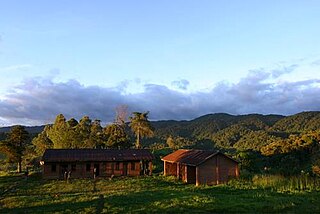
The Itombwe Mountains are a range of mountains in the South Kivu province of the Democratic Republic of the Congo (DRC). They run along the west shore of the northern part of Lake Tanganyika. They contain a vast area of contiguous montane forest and are home to a rich diversity of wildlife.

The Ruwenzori-Virunga montane moorlands is a montane grasslands and shrublands ecoregion of the Rwenzori Mountains and Virunga Mountains in central Africa.

The Kahuzi-Biega National Park is a protected area near Bukavu town in eastern Democratic Republic of the Congo. It is situated near the western bank of Lake Kivu and the Rwandan border. Established in 1970 by the Belgian photographer and conservationist Adrien Deschryver, the park is named after two dormant volcanoes, Mount Kahuzi and Mount Biega, which are within its limits. With an area of 6,000 square kilometres (2,300 sq mi), Kahuzi-Biega is one of the biggest national parks in the country. Set in both mountainous and lowland terrain, it is one of the last refuges of the rare species of Eastern lowland gorilla, an endangered category under the IUCN Red List. The park is a UNESCO World Heritage Site, inscribed in 1980 for its unique biodiversity of rainforest habitat and its eastern lowland gorillas. In 1997, it was listed on the List of World Heritage in Danger because of the political instability of the region, an influx of refugees, and increasing wildlife exploitation.
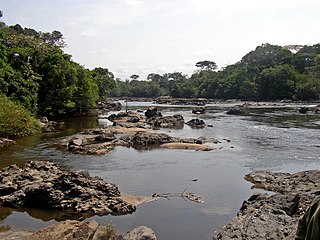
The Northeastern Congolian lowland forests is a tropical moist broadleaf forest ecoregion that spans the Democratic Republic of the Congo and the Central African Republic.

Ceblepyris is a genus of African passerine birds in the cuckooshrike family Campephagidae.
The Kabobo Massif is a mountain region in Tanganyika and South Kivu Provinces, Democratic Republic of the Congo known for its unique flora and fauna. One of its most prominent peaks is Mount Kabobo, while another is known as Misotshi. While Misotshi-Kabogo appears to be a more appropriate name for the massif, it is most commonly referred to in the literature by the misinterpreted name Kabobo.















